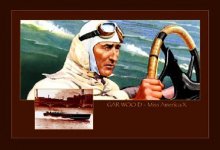Gar Wood. The Detroit-Miami connection.(My title, not theirs)
Gar Wood 5 feet 6, 130 pounds. He loved airplanes and boats, and his marriage of the two made him the international speed king of the water in the 1920s and '30s. Garfield Arthur Wood was a marvel at mechanics. he became the first man to go 100 miles an hour on water, and the first to do two miles a minute in a boat.
He was the son of an Iowa ferry boat operator, Wood an unknown 35-year-old inventor moved to Detroit in 1915. He bought the Miss Detroit a proven winner from Chris Smith, and then went on to win a record five straight Gold Cup Races, with a succession of boats.
In 1917 he decided to put an airplane motor into Miss Detroit III. The experts said it wouldn't work. Wood thought otherwise, figuring that airplane motors had to be more dependable, since there was little margin for engine failure in the air. He bought a Curtiss "12" engine, rebuilt it, and put it into Miss Detroit III. He went on to win the 15th Gold Cup Race on the Detroit River.
Working on engines and boats was the joy of Wood's life. He designed many boats, each more powerful than the last. The hydraulic hoist, was the first of Wood's many inventions and patents which helped make him a multi-millionaire by the time he was 40. He was the first man to design a hull strong enough to handle multiple airplane motors and make world-record speeds while remaining maneuverable.
In 1920, he took his Miss America I speedboat to England to compete for the coveted Harmsworth Trophy.The equivalent of today's America's Cup, Wood won. Detroit's downtown streets were jammed from Belle Isle to Randolph. In America, Gar Wood had become famous. He defended the Harmsworth Trophy eight times.
In 1931, Miss America IX became the first boat to reach 100 mph, topping out at 102.256 mph. That year the Harmsworth race, was held with England's Kaye Don as the chief opponent, his Miss England was powered by a Rolls-Royce motor. It was estimated that a million fans lined the Detroit River to watch the races. Kaye Don got a better start in the first heat and beat Wood, The hometown crowd was shocked. Wood always seemed unbeatable. Before the second heat, Don denied Wood's request for a 45-minute postponement so a crack in Miss America IX's fuel tank could be welded. Risking an explosion, Wood and his mechanic soldered the fuel tank by the starting time.
The start of the second heat was a desperate man-for-man, nerve-against-nerve struggle between Don and Wood to get across the finish line first, each knowing that the difference in speed of the boats was so slight that the one in front would win if it held together. Each boat came down on the starting line in front of the Detroit Yacht Club with the throttles wide open. They hit the starting line almost bow to bow, Wood beat Don to the first turn and the latter capsized going into the backstretch. Wood and Don had beaten the gun by seven seconds, five seconds was all that was allowed. Both Wood and Don were disqualified.
"Wood's Miss America VIII, his brother, George, driving, finished the race, ran again and the Harmsworth stayed in America. For seeming to trick Don over the start, Wood was dubbed "The Gray Fox of Algonac," the name stuck despite Wood's protests that he did nothing of the kind.
Wood built the Gar Jr. II, the world's fastest express cruiser, in 1921. The Gar Jr. II was a V-bottomed displacement boat, A 50-footer with an 11-foot beam. In a feat that captured the nation's imagination , Wood raced the Gar Jr. II against the Havana Special train, up the Atlantic coast from Miami to New York. Wood's boat made the 1,250 mile trip in 47 hours and 23 minutes, beating the train by 12 minutes. Four years later he raced the Baby Gar up the Hudson River between Albany and New York to beat the famed Twentieth Century Limited by 22 minutes. When the Limited left 39 minutes early thousands who were on the banks of the Hudson missed the passing boats.
While Wood was a consistent winner, he had occasional setbacks and near-disasters. In August 1928, his Miss America VI blew up on the St. Clair River. His mechanic, Orlin Johnson, was seriously hurt, Wood, escaped injury but he had no boat. The next race on the Detroit River was in September. He fished his motors out of 90 feet of water, and built a new boat Miss America VII, which he finished in 14 days. He won the race.
Perhaps Wood's greatest design was the Miss America X, called a "madman's dream" Powered by four 1800-horsepower, 12-cylinder Packard engines.
The boat smashed the world record, the first to do over 2 miles a minute: at 124.915 mph. It's a speed that, [64] years later, remains a respectable time for the Gold Cup race on the Detroit River. In 1932, Wood in a rematch had no trouble defeating Kaye Don.
After his final defense with Miss America X in 1933, Wood retired from racing a wealthy man. He and his wife had homes in Detroit, Algonac, Georgian Bay, Miami and Honolulu, and a son, Gar Wood Jr., to carry on the racing tradition. He kept up his friendships with members of the Detroit Yacht Club, which he loved, Wood become its commodore in 1921. Gar Wood died at age 90 in Miami in 1971, a few days before a gigantic civic celebration in his honor was to have been held in Detroit, celebrating the 50th anniversary since his first Harmsworth victory. To the public, he was Tom Swift, Jules Verne, Frank Merriwell and a little bit of Horatio Alger.
(Credit:
http://www.speedboatclassics.com/gar_wood.htm)



